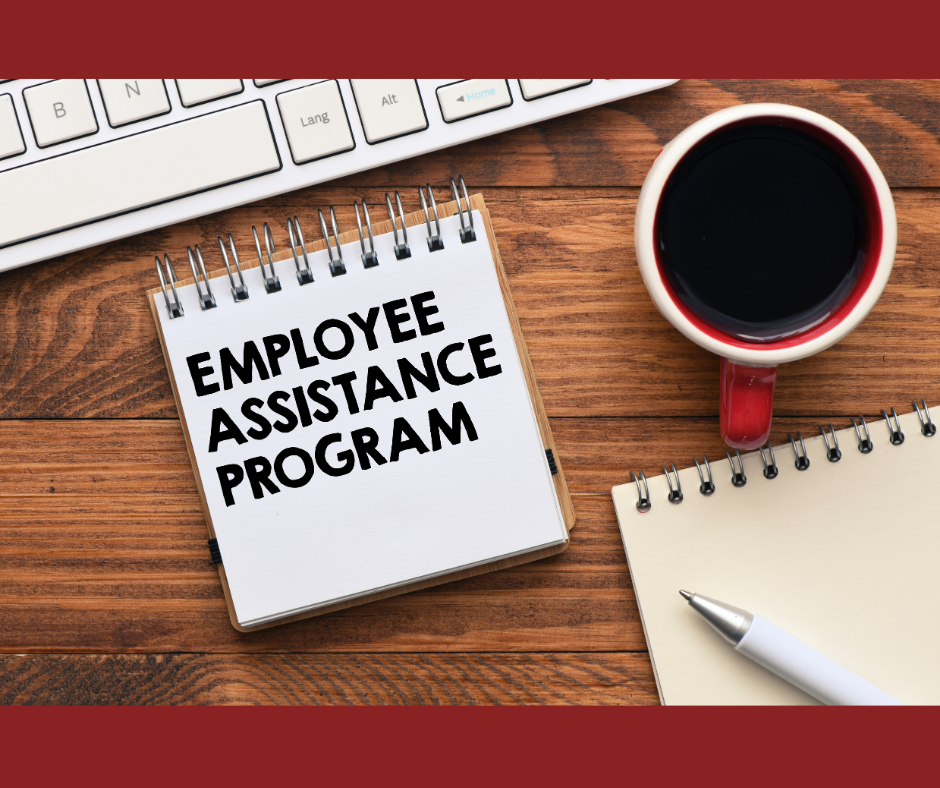
by ckistler | Feb 11, 2021 | Employee Benefits

Employee Assistance Programs (EAP) are company-sponsored programs that provide assistance to employees for a variety of personal issues that may be hindering or adversely affecting their work performance. Typically offered through third-party administrators, EAPs can provide their services online or via telephone and can sometimes be a part of the employee’s healthcare plan, however it is not a replacement to the healthcare plan.
Examples of EAP Services
There is an assortment of services that EAPs offer to employees. All these services have a central purpose: aid the employee so that their personal problems are resolved, and their work performance is unaffected. For example, Karen has been struggling during the COVID-19 pandemic with depression. To sooth her anxiety, she has begun drinking every day. It’s gradually escalated to the point where she is late to work, has frequent absences, and is missing deadlines. She knows she needs to talk with someone who can offer her alcohol abuse resources. She accesses her company sponsored EAP.
Here are some other common services included in EAPs:
- Alcohol and substance abuse counseling
- Health and wellness counseling
- Child or elder care resources
- Legal aid
- Marital and family counseling
- Financial counseling
Benefits of EAP Services
There are a number of benefits to the employee and the employer when the EAP is utilized in the workplace. First, utilizing the EAP service is completely voluntary. Second, the services are provided free of charge to the employee. Third, the counselor that speaks with the employee is entirely confidential. This allows the employee to be completely honest without feeling a threat that the employer would retaliate on anything said in a session.
Utilizing your company’s EAP not only provides services and care to you and your family, but it also benefits your company. No longer carrying the burden of your personal problems solo, an EAP counselor can give you sound advice and steps to follow to achieve success when tackling a problem. Employers will benefit by there being no disruption in the workflow of their employee due to overwhelming personal issues. Access your EAP and attack those personal problems today!

by admin | Oct 4, 2017 | Financial Planning, Hot Topics, Retirement
 The importance of health and wellness in the workplace is more apparent than ever. It’s obvious why healthy individuals make better employees and the positive impact this has on your bottom line. When thinking about building a program to improve the well-being of your employees, don’t forget about the importance of their financial health.
The importance of health and wellness in the workplace is more apparent than ever. It’s obvious why healthy individuals make better employees and the positive impact this has on your bottom line. When thinking about building a program to improve the well-being of your employees, don’t forget about the importance of their financial health.
In recent years, studies show that employees have a wide range of financial concerns that affect their work. Some financial issues are widespread, impacting a large number of employees, while others may be more unique based on an employee’s specific circumstances.
Financial stress in the workplace influences productivity, absenteeism, physical health, emotional well-being, and the overall happiness of employees. Nearly 25 percent of employees confirm personal finance issues are a distraction at work and 39 percent say they spend three hours or more each week at work dealing with personal financial issues.1
Some of the biggest financial stressors impacting employees today include:
- Student loan debt – 2 million Americans collectively owe $1.3 trillion in student loans – that’s more than credit card and auto loan debt, and second only to mortgage debt 2
- Retirement savings – 56 percent of Americans have less than $10,000 in retirement savings 3
- Emergency funds – 46 percent are unable to cover a $400 emergency 4
- Other debt – 48 percent of Americans have more credit card debt than savings 5
Unfortunately, financial stress can go unnoticed because it is usually not as openly discussed or addressed. Discussing personal finance with co-workers and even family members is still considered difficult for many. This makes it even more important to have a program in place to educate and empower your employees to make positive financial decisions.
There are a wide variety of financial wellness programs and services available. When developing a program, be sure that you include both educational resources and tools that support behavioral change.
- Educational resources – Education is the backbone to any financial wellness program. Remember, financial issues can impact anyone in your company and not everyone learns the same way. Offer a variety of resources including workshops, seminars, books, online courses and access to financial consultations. It’s important to assure employees that they are in a safe environment where they can learn and feel comfortable asking questions and seeking more information.
- Empowering behavioral change – Financial wellness doesn’t stop with education. Worksheets, budgeting tools, financial consultants, loan repayment plans and retirement savings plans are all tools that aid employees in making long-term behavioral changes that improve their financial health. Celebrating the small successes early on will help employees commit to making more long-term changes. Be sure to have programs in place that offer the tools and resources needed for employees to set goals, change their behavior and celebrate their success.
Consult with your Employee Assistance Program about resources they may have to help you develop a financial wellness program and empower your employees to get on the path to financial health.
1 PricewaterhouseCoopers, “Employee Financial Wellness Survey,” 2014, page 11
2 Friedman, Zack, “Student Loan Debt in 2017: A $1.3 Trillion Crisis,” Forbes.com, February, 21, 2017, https://www.forbes.com/sites/zackfriedman/2017/02/21/student-loan-debt-statistics-2017/#6d7983a05dab
3 GOBankingRates, “How Much Americans Have Saved for Retirement Survey,” 2016
4 Board of Governors of the Federal Reserve System, “Report on the Economic Well-Being of U.S. Households in 2015,” May 2016, p. 22.
5 Bankrate, “Bankrate Financial Security Index,” 2017
By Nancy Cannon
Originally Published By United Benefit Advisors

by admin | Sep 6, 2017 | Compliance, HIPAA, Human Resources
 When it comes to Employee Assistance Programs, confidentiality is a concern for both employers and employees. As an employer, it is helpful to understand the terms and processes your EAP uses to keep information confidential and ensure that your employees and your workplace are safe.
When it comes to Employee Assistance Programs, confidentiality is a concern for both employers and employees. As an employer, it is helpful to understand the terms and processes your EAP uses to keep information confidential and ensure that your employees and your workplace are safe.
The Health Insurance Portability and Accountability Act (HIPAA) rules apply to EAPs and their affiliate providers. All information that is obtained during an EAP session is maintained in confidential files. The information remains confidential except in the following circumstances:
- An employee/client provides written permission/consent for the release of specific information. This can be done using a Consent to Inform or Release of Information form.
- The life or safety of the client or others is seriously threatened.
- Child abuse has occurred.
- EAP records are the subject of a court order (subpoena).
- Other disclosures required by applicable law.
Depending on the situation, an employee may use EAP services through a self-referral, guided-referral or mandated-referral
Voluntary or self-referrals are the most common. When an employee seeks EAP services voluntarily, all of the employee’s information, including whether he or she contacted the EAP or not, is confidential and cannot be released without written permission.
Guided referrals are an opportunity for the employer to encourage the employee to use EAP services when the employer senses there is a problem that needs to be addressed. This may occur when the employer identifies an employee who may be having personal or work-related difficulties but it is not to the point of mandating that the employee use an EAP. In the case of guided referrals, information disclosed by the employee is still kept confidential.
Mandatory or formal referrals usually occur when substance abuse or other behaviors are impacting productivity or safety. An employer’s policy may allow for putting the employee on a performance improvement plan and may even include a “last chance” agreement that states what an employee must do in order to keep their job. In these cases, employees are mandated by the employer to contact the EAP and a Release of Information is signed so the EAP can exchange information with the employer about employee attendance, compliance and recommendations.
In some cases, it may be advised to send the employee for a Fitness for Duty Evaluation or similar assessment to determine the employee’s ability to physically or mentally perform essential job duties, or assess for a potential threat of violence. These evaluations are performed by specially trained professionals and will come with an additional cost. If the employee has provided written consent, limited information may be released to the employer regarding the results of these evaluations.
By Kathryn Schneider
Originally Published By United Benefit Advisors

by admin | Aug 10, 2017 | Employee Benefits, Human Resources
 Death and loss touch all of us, usually many times throughout our lives. Yet we may feel unprepared and uncomfortable when grief intrudes into our daily routines. As a manager, when grief impacts your employees it’s helpful to have a basic understanding of what they are going through as well as ways you can help.
Death and loss touch all of us, usually many times throughout our lives. Yet we may feel unprepared and uncomfortable when grief intrudes into our daily routines. As a manager, when grief impacts your employees it’s helpful to have a basic understanding of what they are going through as well as ways you can help.
Experiencing Grief
Although we all experience grief in our own way, there are behaviors, emotions and physical sensations that are a common part of the mourning process. J. William Worden’s “Four Tasks of Mourning” will be experienced in some form by anyone who is grieving. These tasks include accepting the reality of the loss, experiencing and accepting our emotions, adjusting to life without the loved one, and investing emotional energy into a new and different life.
Commonly experienced emotions are sadness, anger, frustration, guilt, shock and numbness. Physical sensations include fatigue or weakness, shortness of breath, tightness in the chest and dry mouth.
Manager’s Role
When employees are mourning, it’s important to create a caring, supportive and professional work environment. In most cases, employees will benefit from returning to work. It allows them to resume a regular routine, focus on something besides their loss and boost their confidence by completing work tasks.
At the same time, bereaved employees may experience many challenges when returning to work. They may have poor concentration, be extremely tired, feel depressed or have a short temper and uncontrollable emotions.
As a manager, the best thing you can do is acknowledge the loss and maintain strong lines of communication. Even if you believe someone else is checking in with them, make sure you stay in touch and see if there is anything you can do.
Developing a Return to Work Plan
In order to help your employees have a smooth transition back to work you must listen and understand their needs. Some additional questions you’ll want to answer are:
- What are your company’s policies and procedures for medical and bereavement leave?
- What information do your employees want their co-workers to have and would they rather share this information themselves?
- Do they want to talk about their experience or would they rather focus on work?
- Do they need private time while at work?
- Does their workload and schedule need to be adjusted?
- Do they need help at home – child care, meals, house work, etc.?
- Are there others at work that may be experiencing grief of their own?
Helpful Responses for Managers
- Offer specific help – make meals, wash their car, walk their pet, or anything else that will make their life easier.
- Say something – it can be as simple as, “I’m so sorry for your loss.”
- Listen – be kind but honest.
- Respect privacy – honor closed doors and private moments.
- Expect tears – emotions can hit unexpectedly.
- Thank your staff – for everything they are doing to help.
Grieving is a necessity, not a weakness. It is how we heal and move forward. As a manager, being there for your employees during this time is important in helping them through the grieving process.
An Employee Assistance Program is a great resource for both you and your employees when grief comes to work.
By Kathyrn Schneider
Originally Posted By www.ubabenefits.com

by admin | Apr 14, 2017 | Benefit Management, Group Benefit Plans
 Many employers understand the value of having an Employee Assistance Program (EAP) since the heart and soul of organizations are employees. Employees who are physically and mentally healthy, highly productive, engaged in their work, and loyal to their employer contribute positively to their employer’s bottom line. Fortunately, most employees are positive contributors, yet even the best of employees can occasionally have issues or circumstances arise that may inadvertently impact their jobs in a negative way. Having an EAP in place that can address these issues early may mitigate any negative impact to the workplace. This is a win-win for both employees and employers.
Many employers understand the value of having an Employee Assistance Program (EAP) since the heart and soul of organizations are employees. Employees who are physically and mentally healthy, highly productive, engaged in their work, and loyal to their employer contribute positively to their employer’s bottom line. Fortunately, most employees are positive contributors, yet even the best of employees can occasionally have issues or circumstances arise that may inadvertently impact their jobs in a negative way. Having an EAP in place that can address these issues early may mitigate any negative impact to the workplace. This is a win-win for both employees and employers.
A key component of EAP services lies in “catching things early” by assisting employees and helping them address and resolve issues before they impact the workplace. Most employees will use EAP services on a voluntary, self-referred basis that is completely confidential. Some employers may wonder if services are even being used by employees because it won’t be all that apparent, but most EAPs provide a utilization or usage report that will show the number of people served, and possibly the types of reasons services were requested.
If employee issues do begin to appear in the workplace—related to performance, attendance, behavior, or safety—it is important for managers, supervisors, and human resources to also have access to EAP services. They may wish to consult with an employee assistance professional that can provide guidance and direction leading to problem identification and resolution. These issues have the potential to become very costly for the organization—and again, the earlier they can be addressed, the greater chance of success for both employee and employer, with minimal negative impact to the company’s bottom line.
The key to getting the most out of an EAP is to make it easily accessible to employees, safe to use, and visible enough they remember to use it. It is important that employees understand using the EAP is confidential and their identity will not be disclosed to anyone in their organization. Promoting the EAP services with materials such as flyers, posters, or website information with EAP contact information will also increase the likelihood of employees accessing services.
By Nancy Cannon, Originally Published By United Benefit Advisors






